CLIMATE SCIENTISTS DON'T UNDERSTAND EXACTLY WHAT IS CAUSING THE SHARP INCREASE IN METHANE. ILLUSTRATION: BYHANDS/ROBIN SNASEN RENGÅRD
Methane: a climate blind spot?
Methane is one of the greenhouse gases that contribute most to global warming. Now, recent research show that its levels are increasing, and the researchers don’t know why.
New research, published by the American Geophysical Union, reviews an unexplained increase in methane concentrations since 2007. The sharp increase is alarming because climate scientists don’t understand exactly what is causing it. Perhaps most alarming: this increasing concentration of emissions – if sustained – could derail progress made towards emissions reductions targets laid out under the 2015 UNFCCC Paris Agreement.
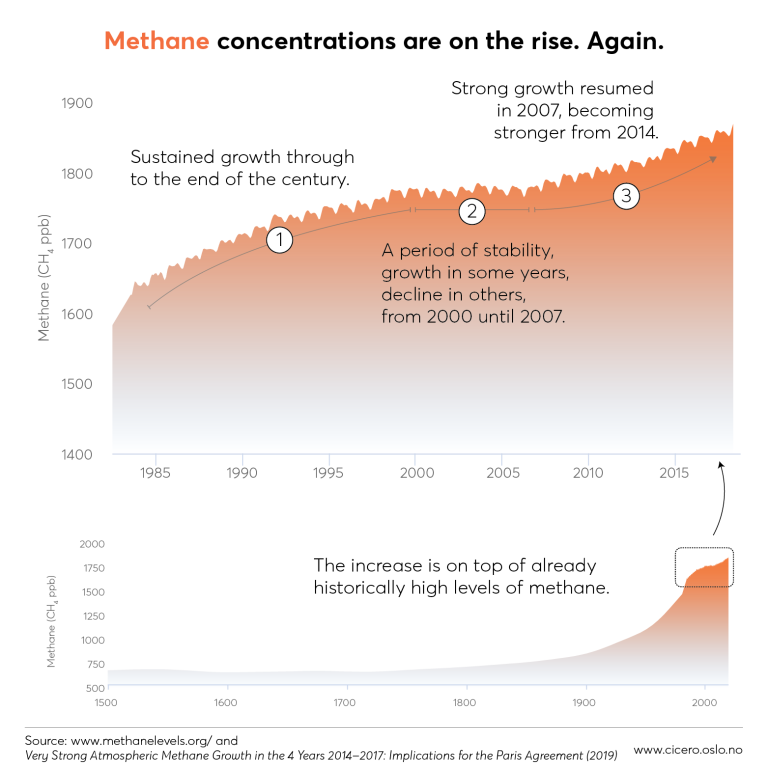
What is methane and why is this increase a problem?
Methane (CH4) is a powerful greenhouse gas that breaks down in about 10 years. In 2014, the world emitted approximately 100 times as much carbon dioxide as methane gas. Looking at the figures from this specific year, new research from CICERO estimates that the heating effect from CH4-emissions, over the next ten years, will exceed the CO2-emissions in that same time period. This differs from a 100 year perspective, because carbon dioxide doesn’t break down.
During much of the 20th century, methane emissions rose, driven largely by rapid, fossil-fuel powered industrialization and expanding agriculture. In the 2000’s, growth in methane concentrations in the atmosphere started to slow down. In the last decade, methane concentrations have begun to rise again, faster than expected. Since methane is significantly more potent than CO2, more methane in the atmosphere gives us less time to reach net-zero greenhouse gas emissions. If the renewed growth in atmospheric methane is sustained, it will put the ambitious Paris Agreement goals even further out of reach.
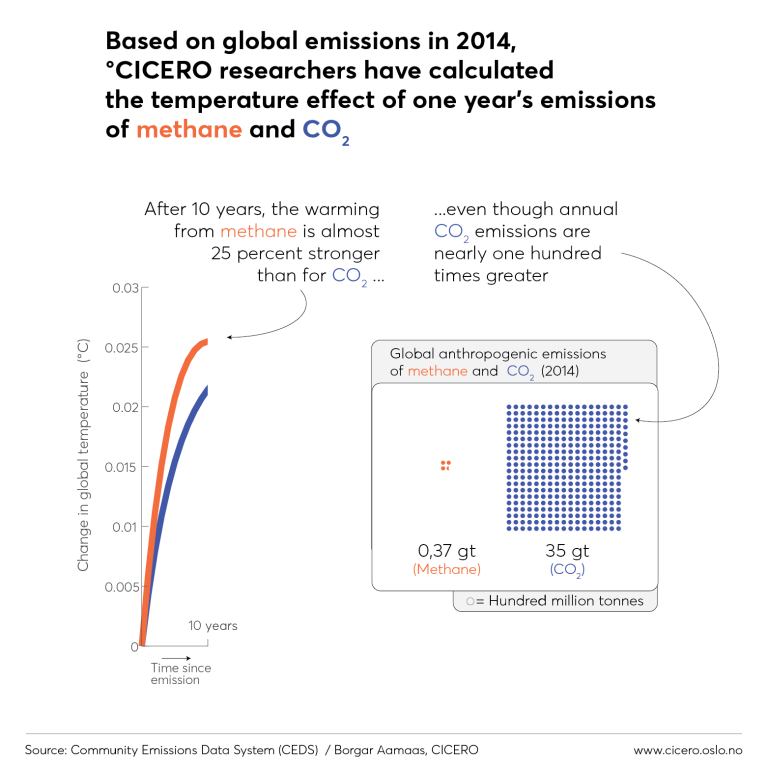
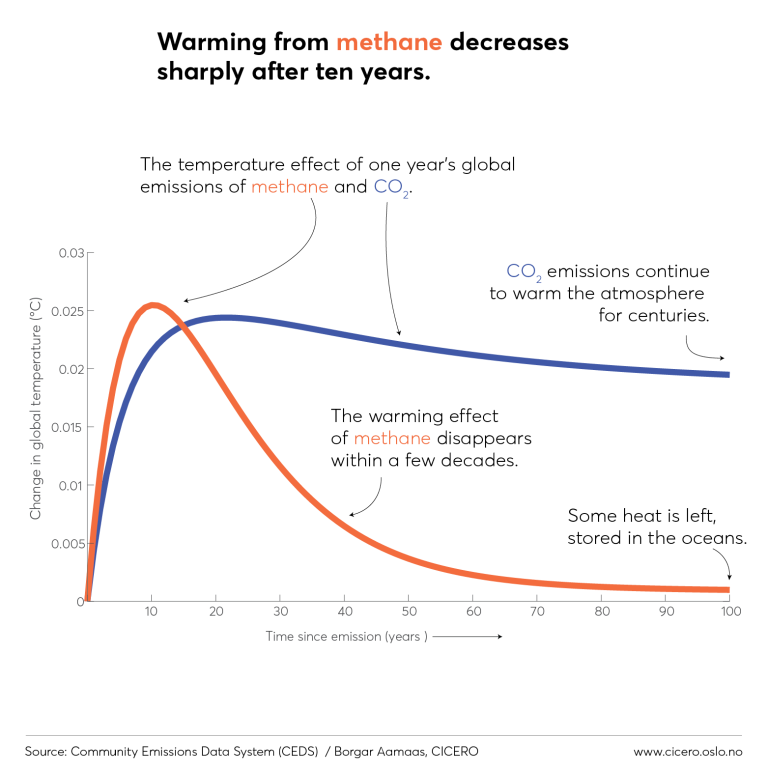
Balancing the methane budget
There are natural and anthropogenic (i.e. man-made) sources of methane emissions. Natural methane emissions are typically balanced out by natural processes that remove methane from the atmosphere, or methane sinks. These sinks break down and oxidize the emissions at approximately the same rate as natural emissions are released; it is the anthropogenic emissions that throw this cycle out of balance.
Most atmospheric methane breaks down through complex chemical reactions with hydroxyl (OH) radicals to produce water vapor, carbon dioxide, and ozone. Methane in the soil is broken down by methane-eating bacteria called methanotrophs. It is the methane that remains in the atmosphere – the methane burden – that causes global warming and so it is particularly important to understand the rate of natural and anthropogenic emissions into the atmosphere (left bars in figure) as well as the processes that remove methane from the atmosphere, the methane sinks (right bars in figure).
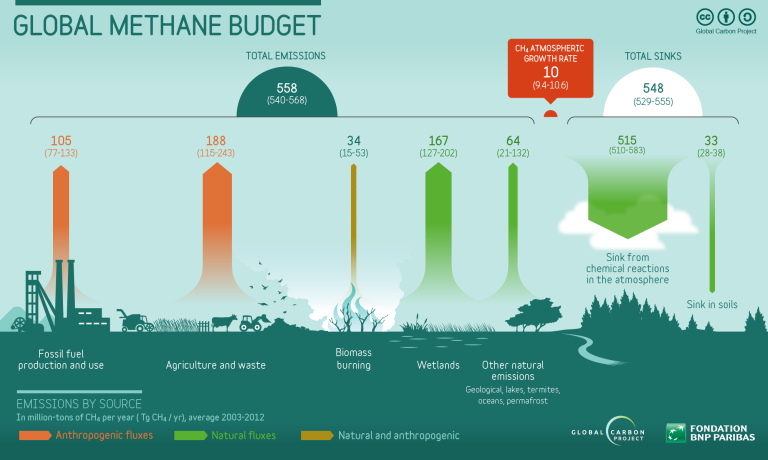
What are the usual sources of methane?
Decaying vegetation in tropical wetlands and flood zones – such as the Amazon, Congo, and Nile wetlands - are by far the most significant natural source of methane and respond quickly (i.e. emit more methane) to increases in warmth and precipitation. Other, smaller sources of natural methane emissions include the digestive processes of termites, melting permafrost, and nutrient-rich sea beds.
Anthropogenic methane emissions can be grouped into three broad categories: agriculture, fossil fuels, and waste.
Agriculture. The digestive processes of ruminants, including cows, are a major source of methane emissions: India, Ethiopia, Brazil, the US and Argentina all have globally significant ruminant populations. It should be noted that in India, the nation with the world’s biggest cattle population, data collected suggests little or no growth in methane emissions between 2010 and 2015 (Ganesan et al.,2017). Burning biomass – from forest fires, agricultural waste incineration, or traditional cookstoves in energy poor areas of the world – also contributes to methane emissions.
Oil and gas. Extraction and distribution of fossil fuels is a significant source of methane emissions, similar in size to agriculture emissions. Methane is a byproduct of coal mining, an industry that is enjoying robust growth in China, India, and Indonesia. Oil and gas extraction releases methane emissions, making up another major source. While natural gas – which is made up predominantly of methane – is a cleaner fossil fuel than coal when burned, pre-combustion gas leaks along supply chains can make it worse than coal. Recent research has found that leak rates – especially from old or abandoned wellheads and aging distribution infrastructure – are substantial and not always accounted for. However, improved technology at the wellhead and improved leak detection and reduction equipment has reduced emissions per unit of natural gas produced in recent years.
Waste. Landfills are a significant source of methane, especially in the tropics where higher temperatures generate greater methane emissions. We have seen lower but steady increases in methane emissions from waste with the rapid expansion of landfills.
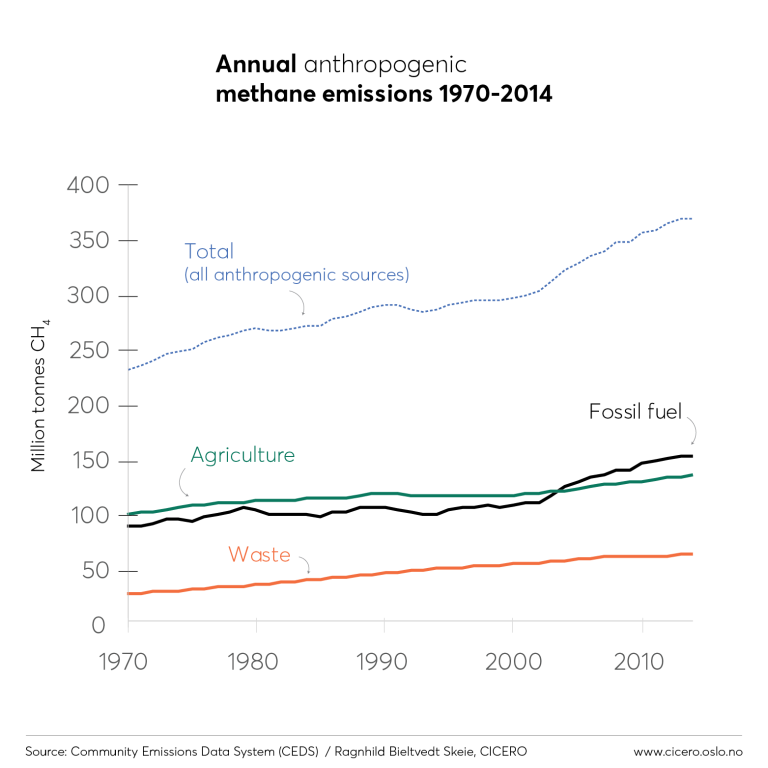
Why is atmospheric methane on the rise?
While the system-level behavior of the methane budget is quite well understood, it is not entirely clear why methane concentrations are growing faster than expected. Are methane emissions growing faster than reported or is the capacity of methane sinks changing?
Scientists studying the issue consider three main causes that are interrelated: increased anthropogenic emissions, increased natural emissions, and reduced capacity of methane sinks.
Scientists studying the issue consider three main causes that are interrelated: increased anthropogenic emissions, increased natural emissions, and reduced capacity of methane sinks.
Anthropogenic methane emissions from ruminants and the fossil fuel industry have increased. Some studies have found that the rapid growth in fracking and deregulated emissions in the US and coal mining in China could be a key driver behind the recent increases.
Natural emissions from wetlands and other flood zones could be driving increases in methane emissions as average temperatures increase year after year and extreme flood events become more common. We have seen evidence of this in the tropics and subtropics already. These climate impacts are likely triggered by increased greenhouse emissions, and so remain within our realm of influence.
Reduced capacity of methane sinks. Changing OH concentration in the atmosphere, caused by other atmospheric pollutants, mean that natural sinks may not be as efficient at breaking down atmospheric methane. It is difficult to directly measure and confirm this hypothesis because OH has such a short lifetime (less than one second). If natural sinks are slower, the methane will remain in the atmosphere longer and cause more warming.
As populations and economies continue to expand, so does consumption of meat, dairy, and energy, driving further increases in fossil fuel demand, expanded agriculture and landfills.
Can we still realistically meet our targets?
In the context of reaching the Paris Agreement goals, the IPCC Summary for Policymakers on Global Warming of 1.5°C (IPCC 2018) highlights the major role that can be played by reductions in methane. It concludes that reducing methane emissions is feasible, especially from fossil fuel sources, and would have rapid impact on global warming. This permits optimism but not complacency: the challenge is large.
It concludes that reducing methane emissions is feasible, especially from fossil fuel sources, and would have rapid impact on global warming. This permits optimism but not complacency: the challenge is large.
Many of the low hanging fruits to slow global warming are methane reductions. Fixing super-emitting leaks from coal mine vents, abandoned natural gas wells and gas distribution networks are high-impact, relatively low-cost targets and can be tackled immediately. Policy intervention is needed to speed progress. Methane capture at landfills is also a realistic and proven technology. Reducing methane emissions from agriculture, in particular from ruminant cattle, is more challenging, but scientific and technological innovations and shifting consumption patterns can play effective roles.
This also presents opportunities for creative policy incentives to help speed reductions in methane. Glen Peters, Research Director at the Center for International Climate Research in Oslo (CICERO) notes that “recent research has suggested methane reductions are now more valuable than previously assumed, and methane increases are more costly than previously assumed. In that sense, methane reductions should get more credit than they currently do.”
Solutions need to address methane sources across the full range of sectors and countries to reach the emissions reduction consistent with the Paris Agreement. The good news is that we already have the technology and understanding we need to effectively reign in manmade methane emissions, and it is often cheaper than widely assumed.
